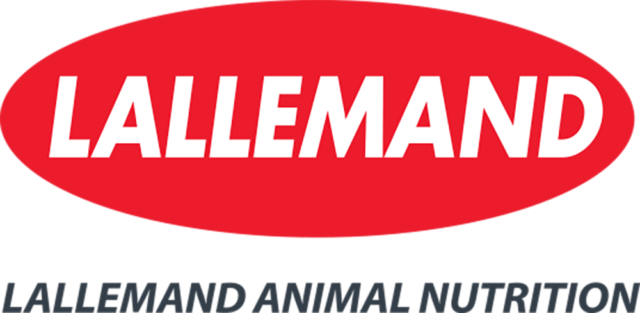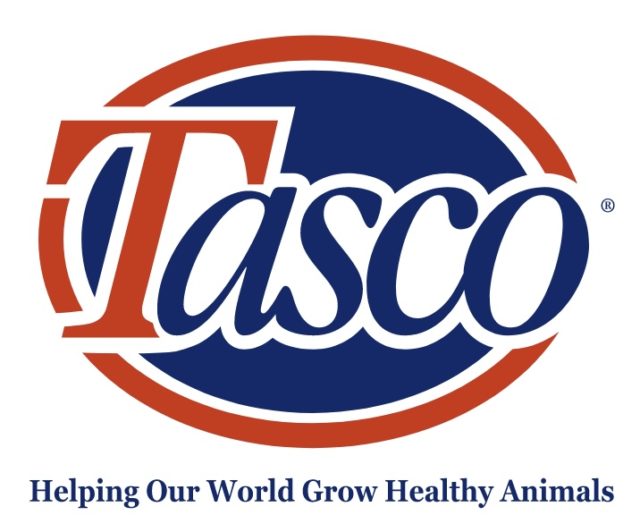What if nutrition during the transition time affects even more than what we see? What if we are even altering the nutrition of the unborn calf – affecting the health and future performance of that animal in two years? As we learn more, we continue to see why these few weeks before and after calving can be the secret to your farm’s success.
Cow management at transition is critical. During this time, the animal is prone to many diseases including rumen acidosis, mastitis, milk fever, retained placenta, ketosis and a displaced abomasum. As cows move from non-lactating to lactating, there truly is a transition in the cow’s physiology, metabolism and nutritional requirements. Crucially, a decrease in dry matter intake (DMI) is occurring. With all these issues plaguing the cow, nutrition needs to be spot-on.
DMI can decrease at a rate of approximately 2% of bodyweight during the first several weeks of the dry period. This ramps up to 1.4% of bodyweight during the seven days prior to calving. As cows approach transition, an overall 30% decrease in DMI may occur rapidly. As DMI decreases, the cow enters negative energy balance, which leads to non- esterified fatty acid (NEFA) release and decreased liver function that leads to ketosis. Or the decrease in blood calcium level can reduce smooth muscle function and lead to retained placenta, milk fever and decrease digestive tract function and cause a displaced abomasum.
How do we assist cows in maintaining energy balance? One strategy is to use concentrated nutrients that take up less room in the already limiting dry matter space, and to balance amino acid levels.
Balancing amino acids
Today’s rumen-protected amino acid products are concentrated nutrients that take comparatively little space in the ration. Their positive effects on transition cows are continuing to be revealed by research.
At transition, if rations contain insufficient levels of amino acids and proteins, cows mobilize their limited protein reserves. These reserves are located in peripheral tissues and muscle. Also, intakes can vary among cows in the pen. Remember, 50% of the cows are eating less than average (Figure 1).
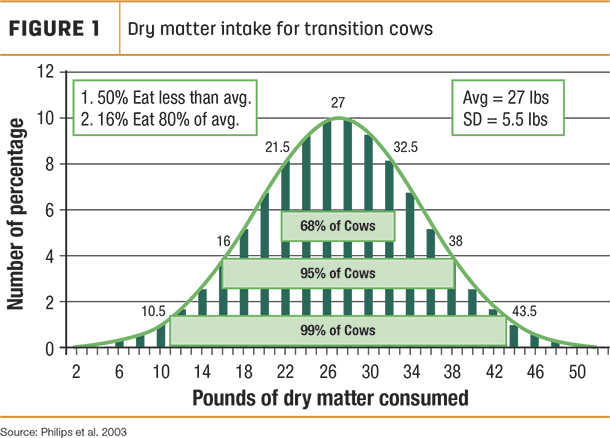
So to supply enough amino acids to these cows, we need to increase the concentration of amino acids.
At transition, the synthesis of proteins and the efficiency of protein synthesis both increase, yet the diet should theoretically require a higher concentration of amino acids due to reduced DMI.
Rumen-protected amino acids can help ease this nutritional burden. By supplementing amino acids, it has been observed that growth hormone and ghrelin are increased in the blood. This results in increased DMI. Cows that have the better amino acid balance have better efficiency, less ketosis and produce more milk.
Precision
A recent transition study using amino acids showed many of the same results that previous work has shown. Experimental cows were fed an additional 17 grams of synthetic rumen-protected lysine. The treatment group consumed more DMI, especially in the week leading up to calving (Figure 2).
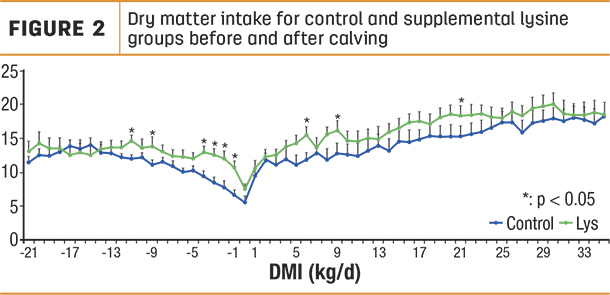 Additionally, milk production was higher and remained higher through the entire lactation even after the supplemental lysine was removed, implying some residual response (Figure 3).
Additionally, milk production was higher and remained higher through the entire lactation even after the supplemental lysine was removed, implying some residual response (Figure 3).
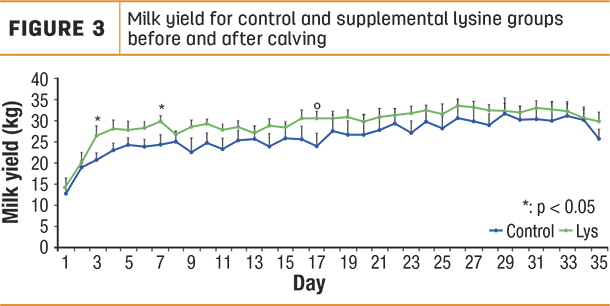
The estimated return on investment (ROI) has been shown on different amino acid strategies throughout the transition phase based off the performance seen in several transition studies (Table 1).
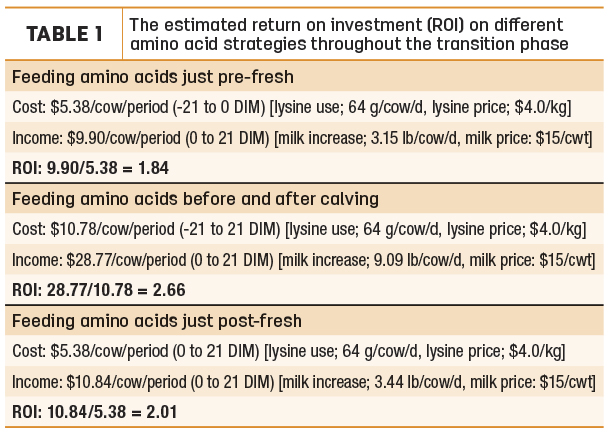
A positive ROI is seen in each situation. However, this doesn’t take into account the benefit received from reduced metabolic conditions – which average around $300 per occurrence. Also, milk production has been shown to be increased throughout the remainder of the lactation as well.
Calf performance
There is a growing body of research that underscores the importance of an amino acid- balanced diet for the developing fetus. During pregnancy, where are the nutrients going which the cow is consuming? According to a paper presented at the 1979 Animal Science meetings, more of it is going to the fetus, especially during the dry period (Figure 4).
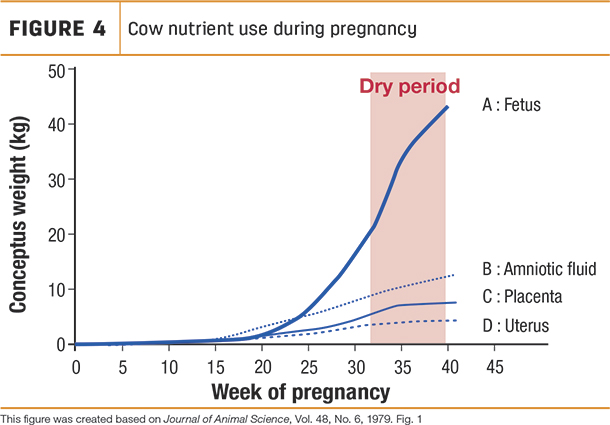
What if what we fed during the dry period affected the unborn calf? A trial was conducted that examined calves born from dams fed rumen-protected amino acids during the transition period versus dams that were not (Figure 6).
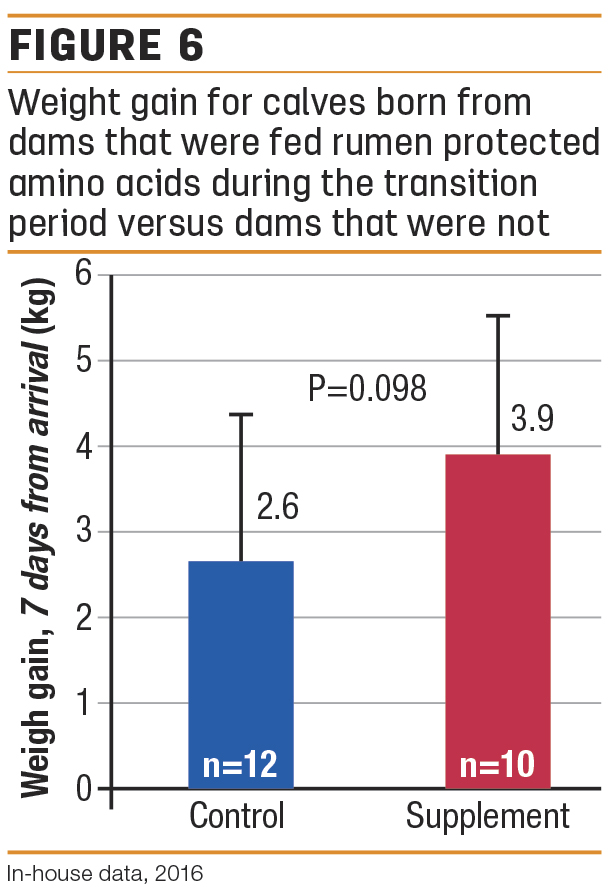
Calves that came from cows who received amino acids gained more weight. Why did this happen? One theory is the calves had better immune systems and were able to absorb the colostrum more correctly.
Figure 5 shows the blood concentration of y-Globulin in the calves’ blood.
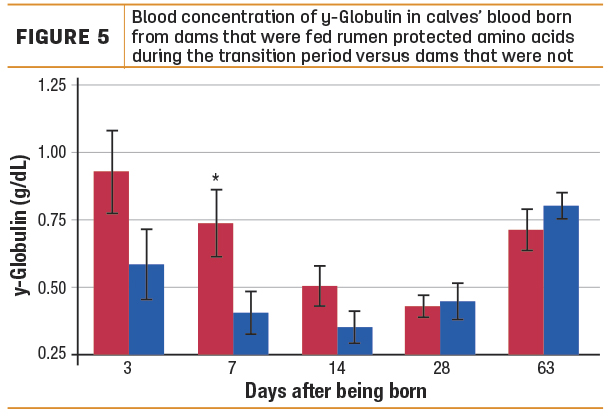
Calves born from control dams (blue) had lower levels of y-Globulin. y-Globulin contains IgG, IgA and IgM, which are very important for neonatal calves’ immunity. Neonatal calves obtain the immunoglobulin from colostrum, yet these calves were fed colostrum from the same source. These results suggest that the dams with a better amino acid balance birthed calves better able to absorb colostrum immunoglobin. This increase in immune system could also lead to less disease incidence in the calf as well.
Transition is and will continue to be the most challenging time in the lactation cycle of dairy cows. However, new nutritional strategies can help lessen the effects and prepare cows to more than ever before reach their full production potential.
Precisely producing more nutrients in the limited amount of diet space available holds the future to higher production and performance. ![]()
References omitted but are available upon request. Click here to email an editor.

-
Jessica Tekippe
- R&D Technical Services Manager
- Ajinomoto Animal Nutrition NA, Inc.
- Email Jessica Tekippe

